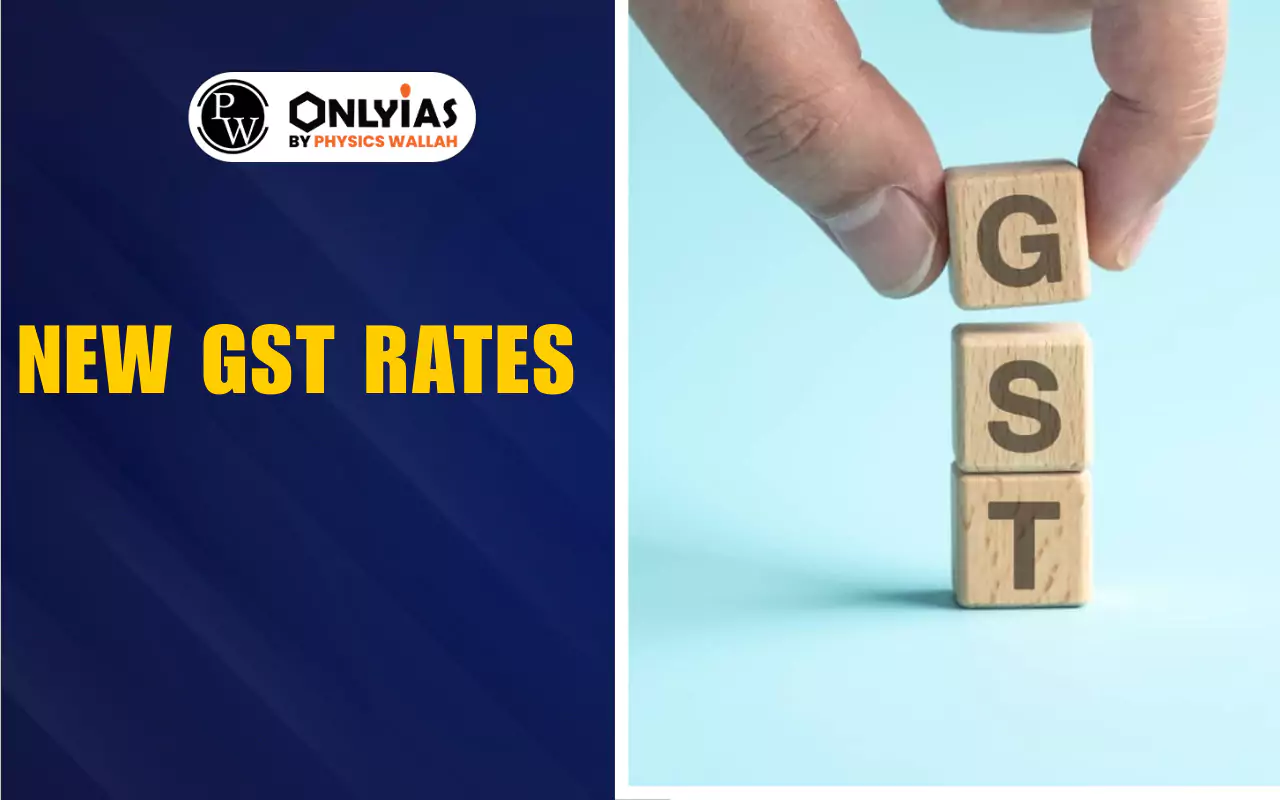New GST Rates 2025 simplify taxation with 5%, 18%, and 40% slabs. Check the New GST Rates 2025 for essential goods, luxury items, and exemptions for easy compliance and savings.

New GST Rates: In the year 2025, the Goods and Services Tax, also referred to as GST has underwent a major change. The GST Council has revised the tax rates to simplify the process and also make it more transparent.
These changes will come into effect from September 22, 2025, and aim to balance revenue collection while ensuring that essential items remain affordable for consumers. Here we provide a comprehensive overview of the new GST rates, slabs, exemptions, and their impact on consumers and businesses.
Goods And Services Tax (GST) Council
The New GST Slabs 2025 have now simplified the existing multi-tier system. Earlier, there were four main slabs: 5%, 12%, 18%, and 28%. With the new reforms, the structure has been streamlined into the following slabs:
The new GST rules make taxes simpler for everyone. Everyday items remain affordable for families, while luxury goods and harmful products are taxed more heavily. This helps people buy wisely and reduces confusion for both shoppers and businesses.
| Category | Recommendation | Previous Rate | Revised Rate |
| Insurance | GST exemption on all individual life insurance (term, ULIP, endowment) and health insurance (including family and senior citizen policies) | 18% | NIL |
| Rate Structure | Simplification of the 4-tier GST structure into 2 rates: Standard (18%) and Merit (5%); Special de-merit rate of 40% for select goods | 0%, 5%, 12%, 18%, 28% | 5%, 18%, 40% |
| Common Household Items | Hair oil, soaps, shampoos, toothbrushes, toothpaste, bicycles, tableware, kitchenware | 12% / 18% | 5% |
| Food Items | UHT milk, paneer, Indian breads (roti, paratha, parotta) | 5% | NIL |
| Packaged foods (namkeens, sauces, noodles, chocolates, coffee, cornflakes, butter, ghee, preserved meat, pasta) | 12% / 18% | 5% | |
| Consumer Goods | TVs (all sizes), ACs, dishwashers, small cars, motorcycles ≤ 350cc | 28% | 18% |
| Agriculture | Tractors, harvesting/threshing machinery, composting machines, balers, mowers | 12% | 5% |
| Labour-Intensive Goods | Handicrafts, marble/granite blocks, intermediate leather goods | 12% | 5% |
| Construction | Cement | 28% | 18% |
| Medicines | 33 lifesaving drugs (12% → NIL); 3 cancer/rare disease medicines (5% → NIL); other drugs (12% → 5%) | 12% / 5% | NIL / 5% |
| Medical Devices | Surgical/dental/veterinary apparatus, diagnostic kits, glucometers, bandages, gauze | 12% / 18% | 5% |
| Automobiles & Transport | Small cars, motorcycles ≤ 350cc, buses, trucks, ambulances | 28% | 18% |
| Uniform rate of 18% on all auto parts; three-wheelers from 28% to 18% | 28% | 18% | |
| Textile Sector | Correction of inverted duty: Manmade fibre (18% → 5%); Yarn (12% → 5%) | 18% / 12% | 5% |
| Fertilizers | Sulphuric acid, nitric acid, ammonia | 18% | 5% |
| Renewable Energy | Renewable energy devices and parts | 12% | 5% |
| Hospitality | Hotel rooms ≤ ₹7,500/day | 12% | 5% |
| Personal Services | Salons, gyms, barbers, yoga centres, wellness services | 18% | 5% |
| Judicial Mechanism | Goods and Services Tax Appellate Tribunal (GSTAT) to be operational by Sept. 2025; hearings to begin by Dec. 2025 | – | – |
Provided here are the details on the key changes that have been made in the new GST structure. Check the information below to get key insights into the same:
In the New GST Rates slab, the reduction from the four main GST slabs to two standard GST slabs is the major change. Earlier, the 12% and 28% slabs were applied to many consumers and industries. This often led to huge confusion in the GST slab. So, now the new GST Rates simplify the tax computation, lower the risk of errors, and speed up the process.
| Previous Slab | New Slab | Applicability |
| 5% | 5% | Essential goods, certain household items |
| 12% | 18% | Standard goods and services |
| 18% | 18% | Standard goods and services |
| 28% | 40% | Luxury goods, sin products |
This approach ensures a clear distinction between essential items and luxury or harmful products, which helps in proper fiscal management.
A special 40% GST rate has been introduced to target luxury and sin items. This category includes:
This measure aims to reduce the consumption of non-essential items. Thereby increasing government revenue from high-value products. It also encourages consumers to prioritize essential and standard goods.
The new GST structure continues to exempt essential goods and services from tax, ensuring affordability for all sections of society. Key exempted items include:
| Category | Examples |
| Unbranded Food Items | Fresh vegetables, fruits, cereals |
| Healthcare Services | Medical consultations, basic treatment |
| Educational Services | School and college tuition, online education courses |
| Unprocessed Agricultural Products | Wheat, rice, pulses, fresh milk |
These exemptions are designed to keep daily necessities accessible to everyone, particularly low- and middle-income households.
To help consumers and businesses understand the tax impact, the new GST rates are divided into categories. These categories show which goods and services fall under each slab.
Certain essential products remain completely tax-free under the 0% GST category. This includes unprocessed food items, basic agricultural products, and healthcare services. The aim is to protect the affordability of basic necessities.
| Products | GST Rate |
| Milk | 0% |
| Kajal | 0% |
| Eggs | 0% |
| Educational Services | 0% |
| Curd | 0% |
| Lassi | 0% |
| Health Services | 0% |
| Children’s Drawing & Colouring Books | 0% |
| Unpacked Foodgrains | 0% |
| Unbranded Atta/Maida | 0% |
| Unpacked Paneer | 0% |
| Gur | 0% |
| Besan | 0% |
| Unbranded Natural Honey | 0% |
| Fresh Vegetables | 0% |
| Salt | 0% |
| Prasad | 0% |
| Palmyra Jaggery | 0% |
| Phool Bhari Jhadoo | 0% |
The 5% slab applies to essential goods and commonly used household products. Examples include:
| Category | Examples |
| Food Items | Sugar, edible oils, flour |
| Personal Care Products | Soap, toothpaste, shampoo |
| Household Appliances | Fans, basic kitchen equipment |
| Medicines | Commonly used drugs and medical supplies |
This low slab reduces the financial burden on households while encouraging consumption of necessary goods.
The 12% slab has been merged with 18% in the new reforms. The 18% GST applies to standard goods and services, including:
| Category | Examples |
| Electronics | Computers, TVs, mobile phones |
| Processed Foods | Packaged snacks, biscuits |
| Clothing | Branded and non-branded apparel |
| Services | Hotels, restaurants, entertainment |
The 18% rate balances revenue collection with consumer affordability.
Luxury and sin products, which previously attracted 28% GST, now fall under the 40% slab. These include:
| Category | Examples |
| Luxury Cars | High-end sedans and SUVs |
| Tobacco Products | Cigarettes, cigars |
| Aerated Drinks | Soft drinks, carbonated beverages |
By taxing these items heavily, the government discourages overconsumption and generates higher revenue from non-essential goods.
The new GST rates affect consumer prices. Some everyday items will become cheaper, while luxury and sin goods may cost more. These changes aim to balance affordability and government revenue.
Consumers can expect a reduction in the cost of several goods and services due to the simplified slab structure. Some of the notable changes include:
Luxury and sin goods are likely to see a price increase due to the new 40% GST slab. These include:
Ready to boost your UPSC 2026 preparation? Join PW’s UPSC online courses today!
The new GST rates are 5%, 18%, and 40%. The 40% rate applies to luxury and harmful goods.
Essential items like milk, eggs, curd, unbranded atta, education, and health services have 0% GST. These items are not taxed to keep them affordable.
Household goods, packaged foods, small appliances, and farm machines are taxed at 5%. This low rate helps families save money on daily items.
Luxury cars, tobacco, and fizzy drinks are taxed at 40%. This higher rate discourages overuse of such items.
Earlier, GST rates were 0%, 5%, 12%, 18%, and 28%. Now they are simplified to 5%, 18%, and 40% for easier understanding.
<div class="new-fform">
</div>
